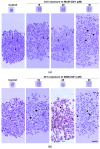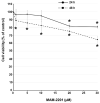Human Astrocyte Spheroids as Suitable In Vitro Screening Model to Evaluate Synthetic Cannabinoid MAM2201-Induced Effects on CNS
- PMID: 36674936
- PMCID: PMC9861655
- DOI: 10.3390/ijms24021421
Human Astrocyte Spheroids as Suitable In Vitro Screening Model to Evaluate Synthetic Cannabinoid MAM2201-Induced Effects on CNS
Abstract
There is growing concern about the consumption of synthetic cannabinoids (SCs), one of the largest groups of new psychoactive substances, its consequence on human health (general population and workers), and the continuous placing of new SCs on the market. Although drug-induced alterations in neuronal function remain an essential component for theories of drug addiction, accumulating evidence indicates the important role of activated astrocytes, whose essential and pleiotropic role in brain physiology and pathology is well recognized. The study aims to clarify the mechanisms of neurotoxicity induced by one of the most potent SCs, named MAM-2201 (a naphthoyl-indole derivative), by applying a novel three-dimensional (3D) cell culture model, mimicking the physiological and biochemical properties of brain tissues better than traditional two-dimensional in vitro systems. Specifically, human astrocyte spheroids, generated from the D384 astrocyte cell line, were treated with different MAM-2201 concentrations (1-30 µM) and exposure times (24-48 h). MAM-2201 affected, in a concentration- and time-dependent manner, the cell growth and viability, size and morphological structure, E-cadherin and extracellular matrix, CB1-receptors, glial fibrillary acidic protein, and caspase-3/7 activity. The findings demonstrate MAM-2201-induced cytotoxicity to astrocyte spheroids, and support the use of this human 3D cell-based model as species-specific in vitro tool suitable for the evaluation of neurotoxicity induced by other SCs.
Keywords: CNS toxicity; human astrocytes; in vitro 3D models; novel psychoactive substances; preclinical studies; public health.
Conflict of interest statement
The authors declare no conflict of interest.
Figures












References
-
- EMCDDA European Drug Report 2019: Trends and Developments. Publications Office of the European Union, Luxembourg. [(accessed on 2 December 2022)]. Available online: http://www.emcdda.europa.eu/system/files/publications/11364/20191724_TDA....
-
- EMCDDA European Drug Report 2022: Trends and Developments. [(accessed on 2 December 2022)]. Available online: https://www.emcdda.europa.eu/publications/edr/trends-developments/2022_en.
-
- Uchiyama N., Kawamura M., Kikura-Hanajiri R., Goda Y. Identification and quantitation of two cannabimimetic phenylacetylindoles JWH-251 and JWH-250, and four cannabimimetic naphthoylindoles JWH-081, JWH-015, JWH-200, and JWH-073 as designer drugs in illegal products. Forensic Toxicol. 2011;29:25–37. doi: 10.1007/s11419-010-0100-3. - DOI
MeSH terms
Substances
LinkOut - more resources
Full Text Sources
Research Materials

